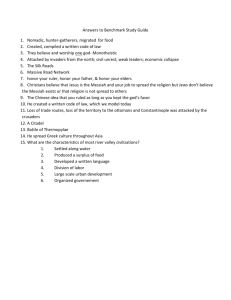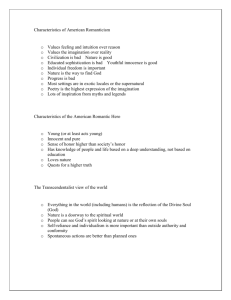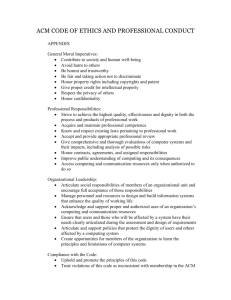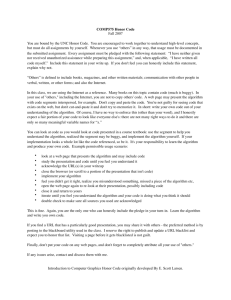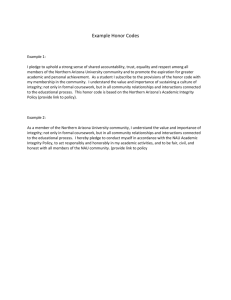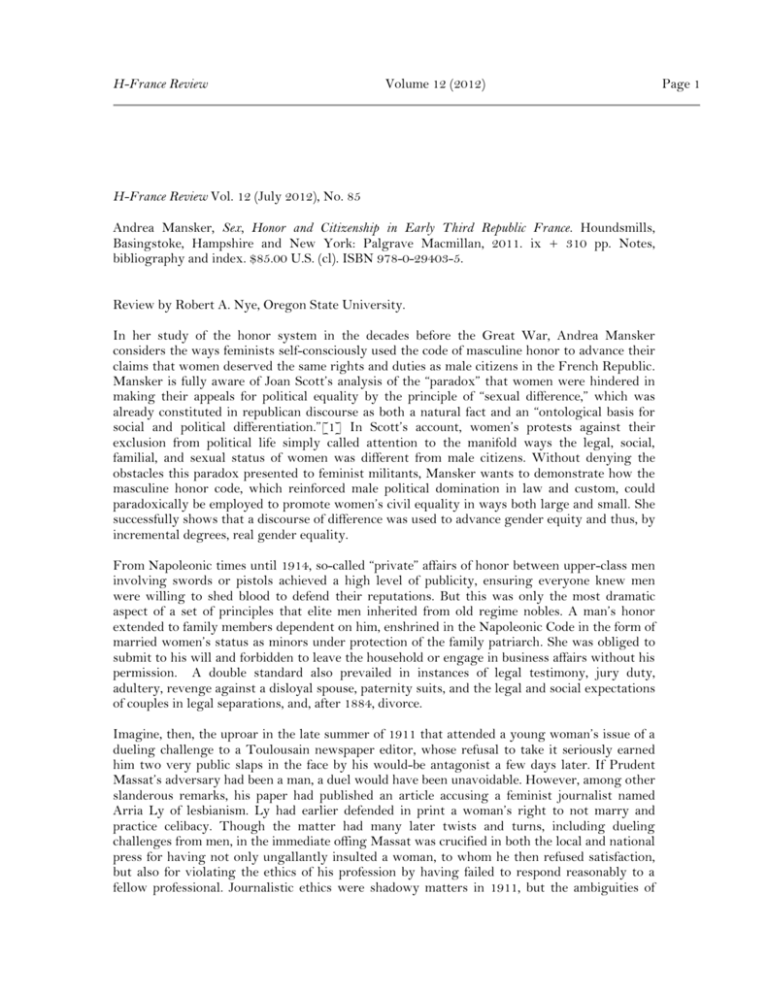
H-France Review
Volume 12 (2012)
H-France Review Vol. 12 (July 2012), No. 85
Andrea Mansker, Sex, Honor and Citizenship in Early Third Republic France. Houndsmills,
Basingstoke, Hampshire and New York: Palgrave Macmillan, 2011. ix + 310 pp. Notes,
bibliography and index. $85.00 U.S. (cl). ISBN 978-0-29403-5.
Review by Robert A. Nye, Oregon State University.
In her study of the honor system in the decades before the Great War, Andrea Mansker
considers the ways feminists self-consciously used the code of masculine honor to advance their
claims that women deserved the same rights and duties as male citizens in the French Republic.
Mansker is fully aware of Joan Scott’s analysis of the “paradox” that women were hindered in
making their appeals for political equality by the principle of “sexual difference,” which was
already constituted in republican discourse as both a natural fact and an “ontological basis for
social and political differentiation.”[1] In Scott’s account, women’s protests against their
exclusion from political life simply called attention to the manifold ways the legal, social,
familial, and sexual status of women was different from male citizens. Without denying the
obstacles this paradox presented to feminist militants, Mansker wants to demonstrate how the
masculine honor code, which reinforced male political domination in law and custom, could
paradoxically be employed to promote women’s civil equality in ways both large and small. She
successfully shows that a discourse of difference was used to advance gender equity and thus, by
incremental degrees, real gender equality.
From Napoleonic times until 1914, so-called “private” affairs of honor between upper-class men
involving swords or pistols achieved a high level of publicity, ensuring everyone knew men
were willing to shed blood to defend their reputations. But this was only the most dramatic
aspect of a set of principles that elite men inherited from old regime nobles. A man’s honor
extended to family members dependent on him, enshrined in the Napoleonic Code in the form of
married women’s status as minors under protection of the family patriarch. She was obliged to
submit to his will and forbidden to leave the household or engage in business affairs without his
permission. A double standard also prevailed in instances of legal testimony, jury duty,
adultery, revenge against a disloyal spouse, paternity suits, and the legal and social expectations
of couples in legal separations, and, after 1884, divorce.
Imagine, then, the uproar in the late summer of 1911 that attended a young woman’s issue of a
dueling challenge to a Toulousain newspaper editor, whose refusal to take it seriously earned
him two very public slaps in the face by his would-be antagonist a few days later. If Prudent
Massat’s adversary had been a man, a duel would have been unavoidable. However, among other
slanderous remarks, his paper had published an article accusing a feminist journalist named
Arria Ly of lesbianism. Ly had earlier defended in print a woman’s right to not marry and
practice celibacy. Though the matter had many later twists and turns, including dueling
challenges from men, in the immediate offing Massat was crucified in both the local and national
press for having not only ungallantly insulted a woman, to whom he then refused satisfaction,
but also for violating the ethics of his profession by having failed to respond reasonably to a
fellow professional. Journalistic ethics were shadowy matters in 1911, but the ambiguities of
Page 1
H-France Review
Volume 12 (2012)
insult and offense were regularly settled in affairs of honor, which Massat had denied to his
female accuser.
Mansker rightly attaches importance to this unusual incident. By challenging Massat, she was
publicly displaying a physical courage out of the ordinary for her sex. She was also asserting her
personal autonomy and her identity as a professional journalist, qualities that her male
contemporaries acknowledged she possessed and was justified in defending, however unpopular
her views on marriage and procreation. In explaining why she preferred “a public and official
letter of apology” (p.51, emphasis original) over a legal settlement awarded by a tribunal, she
was asserting her right to behave as a male journalist would have done. In short, she knew the
code and turned it to her advantage. Ly’s slap drew attention away from her sex to her
performance of outraged honor, which would have reminded many of the observers of this event
of Sarah Bernhardt’s contemporary “trouser” roles where the focus was on the performance, not
the body of the performer.
By 1911, however, much had already changed in the ways the “woman question” played out in
French civil society. The sphere of women’s rights had slowly expanded in the years since the
founding and solid establishment of the Republic in surprising ways, subjects Mansker tackles
in subsequent chapters. A number of developments made it possible for feminists to use the
honor/shame system to press for legislation beneficial to women and to rebalance the male bias
in the code to their advantage. The first of these was the growing demographic crisis. Not only
was France’s birth rate lower than its neighbors, but by 1906 the male/female ratio had skewed
in women’s favor by 650,000. There was a growing “surplus” of single women in the fertile
years between the ages 15 to 49 amounting to 37.1 percent of this age group, with divorcees and
widows making up 5.2 percent and married women 57.7 percent. The best-educated and well-off
young women married at very low rates. Many were teachers in the new republican schools, but
it was, in any case, increasingly common to see single women out and about in urban areas
working in a variety of different occupations.
The implications of these figures alarmed demographers, medical experts, and politicians, many
of whom concluded that various pathologies had sapped the reproductive vitality of men and
women and were causing a degeneration of the “race.” Mansker adds an important dimension to
the scholarship on this intensely debated crisis. Men, of course, came in for their share of blame,
but women like Arria Ly who chose celibacy and refused to marry were demonized. They were
accused either of frigidity or anaphrodisie, or, inversely, of abusing the “natural” reproductive
instinct in self-indulgent or perverted ways. In either case, these speculations focused attention
on the sexuality of both men and women and stirred a debate about the ways the nation could
modernize marriage, make it more attractive to women and somehow stimulate population
growth.
Unhappy marriages were often infertile ones, and the Naquet law of 1884, permitting divorce
with fault, was at least in part motivated by the assumption that remarriages would be
productive. Mansker examines a range of divorce pleas in the Seine tribunals and elsewhere to
follow the jurisprudence on the injure grave, which was, after adultery and cruelty, the most
serious grounds for divorce. In divorce proceedings, the injure grave could be given or received
by either a man or a woman, but the term itself was borrowed from the male honor code’s
description of an affront serious enough to provoke a dueling challenge. By 1913 this category
surpassed all other grounds in the 21,922 divorce and separation suits filed that year. Mansker’s
sample cases show that, particularly in middle-class divorce suits, republican judges played the
role of “surrogates of women’s honor” (p. 92) against neglectful or abusive husbands. They also
Page 2
H-France Review
Volume 12 (2012)
awarded divorces to women whose spouses had not fulfilled their conjugal duties, refused
cohabitation, or whose impotence prevented sexual relations. The jurisprudence evolved to
demand “affectionate assistance” from husbands and a notion that healthy spousal relations
depended on a mutual “solidarity of honor” between equals (pp. 110, 99). Though she was still a
legal minor and obliged to behave virtuously, a married woman’s status and dignity in the
marital relationship received here a direct affirmation by state authority. If a woman’s sexual
virtue was a key element in the honorable reputation of the family, so, increasingly, was a man’s.
Upon her divorce a woman regained full civil capacity but retained her husband’s name. In the
debates that led up to the passage of the Naquet law, legislative opinion seemed to favor the
notion that returning the divorcee’s birth name would lessen the danger to the husband’s family
and personal honor in the event of her misbehavior or financial recklessness. A law to this effect
was finally passed in 1893 and, by the same logic, was also extended to separated women.
Ironically, as Mansker points out, it likely accrued more to the honorability of the divorcee. In
order to cut ties definitively with her husband’s family, the law returned a woman’s marital
assets to her and gave her full control over their disposition. She thus regained not only her
civic and financial autonomy, but her own name and a fresh start in the world. Never-married
women shared the same status, but, however much regret a woman might have felt about a
failed marriage, she surely experienced her divorce as an elevation of her civic status.
But what to call her, Madame or Mademoiselle? As it happens, the adoption by married women
of the husband’s name was not required by the civil code, but was entirely customary. In order
to build a sense of independence in married women and to construct a foundation for single
women’s civic equality, Mansker shows how Hubertine Auclert and other feminists mounted a
multi-pronged campaign around the turn of the century. First, they wished to attain
acknowledgement of the practical and legal civil independence of single women, widows, and
divorcees by granting them the vote. They encouraged women to retain their birth names upon
marriage, and third, they demanded all women be addressed as Madame upon attaining their
majority. The title Mademoiselle, built on the root word for a young woman (demoiselle),
weighed heavily on an unmarried woman as she aged. Madame was thus an honorific that
allowed women to escape this fate, and for some might have lessened the pressures to marry.
Auclert thus played the “surplus women” card, hoping that the growing numbers of single
women and their increasing importance in the economy would persuade republican legislators.
She was disappointed, not only in her enemies, but in her friends, like the feminist René Viviani,
who chose the “pure” path of demanding suffrage for all women tout court. The Gautret voting
initiative thus failed. Nor did new brides seek to retain their birth names when they married in
large numbers. But the debates about Madame or Mademoiselle did bear some fruit, even if the
final harvest did not arrive until 2012. Professional women started to adopt the title Madame
around the turn of the century. By doing so, they helped detach the term from its conceptual
foundation in marriage and repositioned it as an acknowledgement of female sexual maturity
and professional and educational achievement. Republican legislators continued to resist giving
women the vote, but the early decision to educate women had created in many of them an
irreversible desire for material and symbolic forms of independence.
Finally, Mansker explores the pre-war feminist strategy to achieve a greater degree of civic
equality between the sexes in the fin-de-siècle battle over prostitution and the looming threat of
venereal disease. In this they learned from the headway made by British feminists who had
successfully overturned the regulationist regime of prostitution there in 1886. The “venereal
peril” debates that crested near the turn of the century grew out of the same fears of rampant
Page 3
H-France Review
Volume 12 (2012)
disease and depopulation that fueled the campaigns against public nudity, vice, alcoholism, and
sexual perversions. An extra-parliamentary commission was assembled in 1903 to consider,
among other things, a revision of the regulatory regime in France. The only female member of
the commission was Avril de St. Croix. Mansker has dug into the procès-verbaux of the
commission’s meetings and sampled the widespread public debate on the issue. She found that
St. Croix and other feminists employed a discourse that brought attention to the shameful and
uncontrollable behavior of men and which perpetuated the degradation of women in brothels,
contributed to the spread of disease, and even the infection of “honest” women by their
husbands.
Feminists freely used the image of women as the gardiennes of the foyer to demand an egalitarian
sexual ethic on behalf of both national health and family honor. In her work on the commission,
St. Croix could not defeat the arguments of her colleagues that regulationism should be
preserved in the interests of public health, but she could speak at length about her own efforts to
rescue prostitutes in the name of women’s rights, and regularly exposed the male bias of the
commissioners. She also extracted the concession from fellow commissioners that prostitution
was not in itself a crime, and that all women had the right to control their own bodies.
Feminists had both Protestant and Catholic allies in their efforts to reveal French gallantry as a
moral and physical weakness in men. In contrast to the men who visited brothels and infected
their wives, the women who demanded their husbands’ respect, loyalty, and sexual fidelity were
defenders of the honor of the family and could lay claim to equal, if not superior, moral status. In
the battle for national health, women could thus claim to be strong, resolute, and committed to
the welfare of the state. They staked out this right in the act of breaking the silence surrounding
prostitution and engaging vigorously in public debate.
Mansker sets out these arguments with great clarity and impressive documentation. She
successfully demonstrates how feminist advocates of civil and political equality for women
criticized the demeaning double standard inscribed in the civil code by invoking the prevailing
code of honor to which men were obliged to adhere if they aspired to honorable status. In the
absence of dramatic legislative victories, Mansker expertly teases out the ways women were
able to make use of legal and cultural argument to advance their material equity and symbolic
civic equality. She does this with remarkable insight, with notable attentiveness to language
and the law, and a subtle grasp of the way the honor codes functioned in public life, for men, of
course, but for women too. Those of us who have stressed the masculine aspects of honor in our
work are richly and justly reproved.
NOTES
[1] Joan Scott, Only Paradoxes to Offer: French Feminists and the Rights of Man (Cambridge,
Mass.: Harvard University Press, 1996), p. 3.
Robert A. Nye
Oregon State University
nyer@onid.orst.edu
Copyright © 2012 by the Society for French Historical Studies, all rights reserved. The Society
for French Historical Studies permits the electronic distribution of individual reviews for
nonprofit educational purposes, provided that full and accurate credit is given to the author, the
Page 4
H-France Review
Volume 12 (2012)
date of publication, and the location of the review on the H-France website. The Society for
French Historical Studies reserves the right to withdraw the license for
edistribution/republication of individual reviews at any time and for any specific case. Neither
bulk redistribution/ republication in electronic form of more than five percent of the contents of
H-France Review nor re-publication of any amount in print form will be permitted without
permission. For any other proposed uses, contact the Editor-in-Chief of H-France. The views
posted on H-France Review are not necessarily the views of the Society for French Historical
Studies.
ISSN 1553-9172
Page 5


